Effect of (NbTi)C Particles on the Microstructure and Hardness of High Chromium and Nickel Indefinite Chilled Cast Iron
Abstract
:1. Introduction
2. Materials and Methods
3. Results
3.1. Microstructure
3.2. Hardness
4. Discussion
5. Conclusions
- The addition of different contents of (NbTi)C particles can improve the microstructure of ICCI, including increasing the content of M3C-type carbides and resulting in finer and more uniform dendrites, in which (NbTi)C particles exist as granules, rods of about 10 μm in length, and polygons.
- The Thermo-Calc simulation has shown that during solidification, the γ phase, graphite, and Fe3C precipitate in liquid phase in turn, and the liquid phase transformed into a solid phase at 1131 °C. The eutectic (NbTi)C particles may be formed in the transformation of L→γ + (NbTi)C + Fe3C.
- The hardness of ICCI increased with an increasing addition (NbTi)C particles. When the addition amount was 0.80 wt %, the hardness reached 54.4 HRC, which is 21.1% higher than that without addition, mainly due to the increase and refinement of carbides.
Author Contributions
Funding
Institutional Review Board Statement
Informed Consent Statement
Data Availability Statement
Conflicts of Interest
References
- Kim, S.H.; Baek, E.R.; Jang, B.K. The effect of vanadium addition on the fracture and wear resistance of indefinite chilled cast iron. Mater. Today Commun. 2020, 26, 101819. [Google Scholar] [CrossRef]
- Moonesan, M.; Raouf, A.H.; Madah, F.; Zadeh, A.H. Effect of alloying elements on thermal shock resistance of gray cast iron. J. Alloys Compd. 2012, 520, 226–231. [Google Scholar] [CrossRef]
- Huang, G.Z.; Li, Z.H. Effect of vanadium and niobium on the microstructure of carbide reinforced indefinite chilled cast rolls. Adv. Mater. Res. 2011, 311–313, 864–870. [Google Scholar] [CrossRef]
- Tercelj, M.; Fajfar, P.; Godec, M.; Kugler, G. Characteristics of the thermal fatigue resistance for 3.1C, 0.8Si, 0.9Mn, 1.7Cr, 4.5Ni and 0.3Mo ICDP cast iron roll at 600 °C. Mater. Technol. 2017, 51, 515–521. [Google Scholar] [CrossRef]
- Ahiale, G.K.; Choi, W.D.; Suh, Y.; Lee, Y.K.; Oh, Y.J. Effect of MC-type carbide forming and graphitizing elements on thermal fatigue behavior of indefinite chilled cast iron rolls. Metall. Mater. Trans. A 2015, 46, 4819–4827. [Google Scholar] [CrossRef]
- Huang, G.Z.; Shi, D.S.; Zhang, L.Y.; Li, Q. Effect of Nb and V contents on microstructure of carbide reinforced indefinite chilled rolls. Heat Treat. Metals 2014, 39, 58–62. [Google Scholar]
- Bombac, D.; Kugler, G.; Markoli, B.; Tercelj, M. Hot work roller surface layer degradation progress during thermal fatigue in the temperature range 500–700 °C. Int. J. Fatigue 2017, 104, 355–365. [Google Scholar] [CrossRef]
- Ha, D.J.; Sung, H.K.; Park, J.W.; Lee, S. Effect of alloying elements on microstructure, hardness, wear resistance, and surface roughness of centrifugally cast high-speed steel rolls. Metall. Mater. Trans. A 2009, 40, 2568. [Google Scholar] [CrossRef] [Green Version]
- Bedolla-Jacuinde, A.; Correa, R.; Quezada, J.G.; Maldonado, C. Effect of titanium on the as-cast microstructure of a 16% chromium white iron. Mater. Sci. Eng. A 2005, 398, 297–308. [Google Scholar] [CrossRef]
- Huang, Z.F.; Xing, J.D.; Zhi, X.H.; Gao, Y.M. Effect of Ti addition on morphology and size of primary M7C3 type carbide in hypereutectic high chromium cast iron. Mater. Sci. Technol. 2011, 27, 426–430. [Google Scholar] [CrossRef]
- Tian, Y.J.; Wu, H.Q.; Guo, J.H.; Li, F.R. Effect of RE inclusions on heterogeneous nucleation of primary austenite in Fe-C alloys. J. Chin. Rare Earth Soc. 1988, 6, 45–48. [Google Scholar]
- Bramfitt, B.L. Planar lattice disregistry theory and its application on heterogistry nuclei of metal. Metall. Trans. 1970, 1, 1987–1995. [Google Scholar] [CrossRef]
- Radulovic, M.; Fiset, M.; Peev, K. Effect of rare earth elements on microstructure and properties of high chromium white iron. Mater. Sci. Technol. 1994, 10, 1057–1062. [Google Scholar] [CrossRef]
- Li, C.H.; Song, Y.P.; Wei, X.; Lu, C.; Liu, B.C.; Han, Y.T. Effect of heat treatment on microstructures and properties of RE-Nb modification chilled cast iron. Spec. Cast. Nonferrous Alloy. 2014, 34, 623–625. [Google Scholar]
- Guo, E.; Wang, L.; Huang, Y. Effect of RE, V, Ti, and B composite modification on the microstructure and properties of high chromium cast iron containing 3% molybdenum. Rare Met. 2009, 28, 6. [Google Scholar] [CrossRef]
- Yang, F.; Xia, P.; Kou, X.; Wang, Y.; Zhang, W. Effect of RE-Al compound modifier on microstructure and properties of Ni-Cr-Mo chilled cast iron used for casting roll. Foundry Technol. 2015, 36, 972–976. [Google Scholar]
- Gou, J.; Wang, Y.; Wang, C.; Chu, R.; Liu, S. Effect of rare earth oxide nano-additives on micro-mechanical properties and erosion behavior of Fe-Cr-C-B hardfacing alloys. J. Alloys Compd. 2017, 691, 800–810. [Google Scholar] [CrossRef]
- Zhu, H.W.; Ke, W.J.; Zhao, Z.P.; Qin, S.; Xiao, F.R.; Liao, B. Refinement effectiveness of self-prepared (NbTi)C nanoparticles on as-cast 1045 steel. Mater. Des. 2018, 139, 531–540. [Google Scholar] [CrossRef]
- Zhu, H.W.; Xu, K.; Qin, S.; Xiao, F.R.; Liao, B. Effect of heat treatment on microstructure and properties of 1045 steel modified with (NbTi)C nanoparticles. Mater. Sci. Eng. A 2018, 728, 175–182. [Google Scholar] [CrossRef]
- Zhu, H.W.; Li, H.N.; Xiao, F.R.; Gao, Z.X. Study on the dissolution and precipitation behavior of self-designed (NbTi)C nanoparticles addition in 1045 steel. Metals 2021, 11, 184. [Google Scholar] [CrossRef]
- Liu, S.; Zhou, Y.; Xing, X.; Wang, J.; Yang, Q. Refining effect of TiC on primary M7C3 in hypereutectic Fe-Cr-C harden-surface welding coating: Experimental research and first-principles calculation. J. Alloys Compd. 2017, 691, 239–249. [Google Scholar] [CrossRef]
- Liu, S.; Zhang, J.; Wang, Z.; Shi, Z.; Zhou, Y.; Ren, X.; Yang, Q. Refinement and homogenization of M7C3 carbide in hypereutectic Fe-Cr-C coating by Y2O3 and TiC. Mater. Charact. 2017, 132, 41–45. [Google Scholar] [CrossRef]
- Song, Y.; Cui, J.; Rong, L. Microstructure and mechanical properties of 06Cr13Ni4Mo steel treated by quenching–tempering-partitioning process. J. Mater. Sci. Technol. 2015, 32, 189–193. [Google Scholar] [CrossRef]
- Sun, G.F.; Liu, C.S.; Tao, X.Q.; Chen, S.Y. Research on laser alloying of high-Ni-Cr infinite chilled cast iron roller. J. Northeast. Univ. 2008, 29, 845–848. [Google Scholar]
- Zheng, B.; Xing, J.; Li, W.; Tu, X.; Jian, Y. Effect of chromium-induced (Fe,Cr)3C toughness improvement on the weo-body abrasive wear behaviors of white cast iron. Wear 2020, 456–457, 203363. [Google Scholar] [CrossRef]
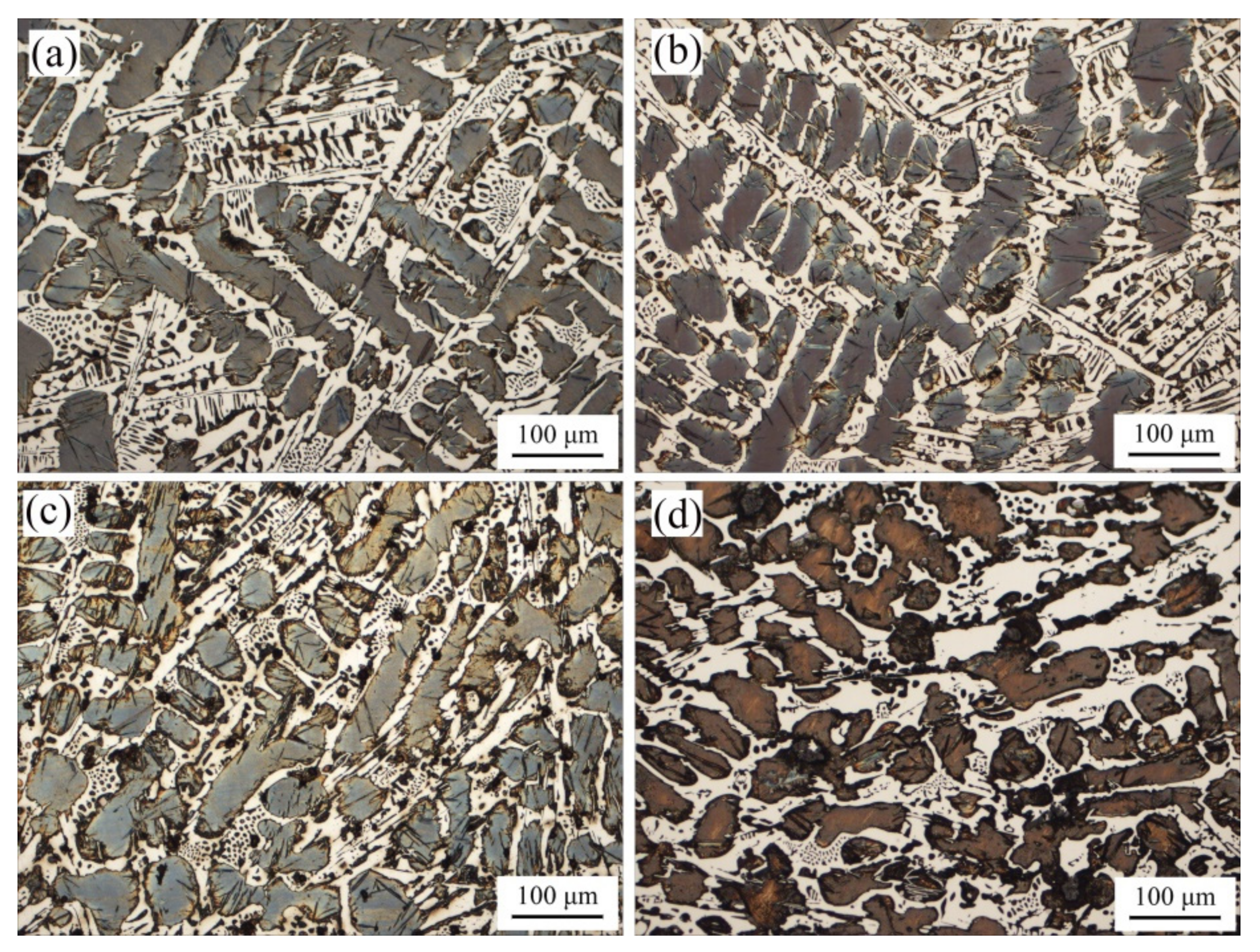
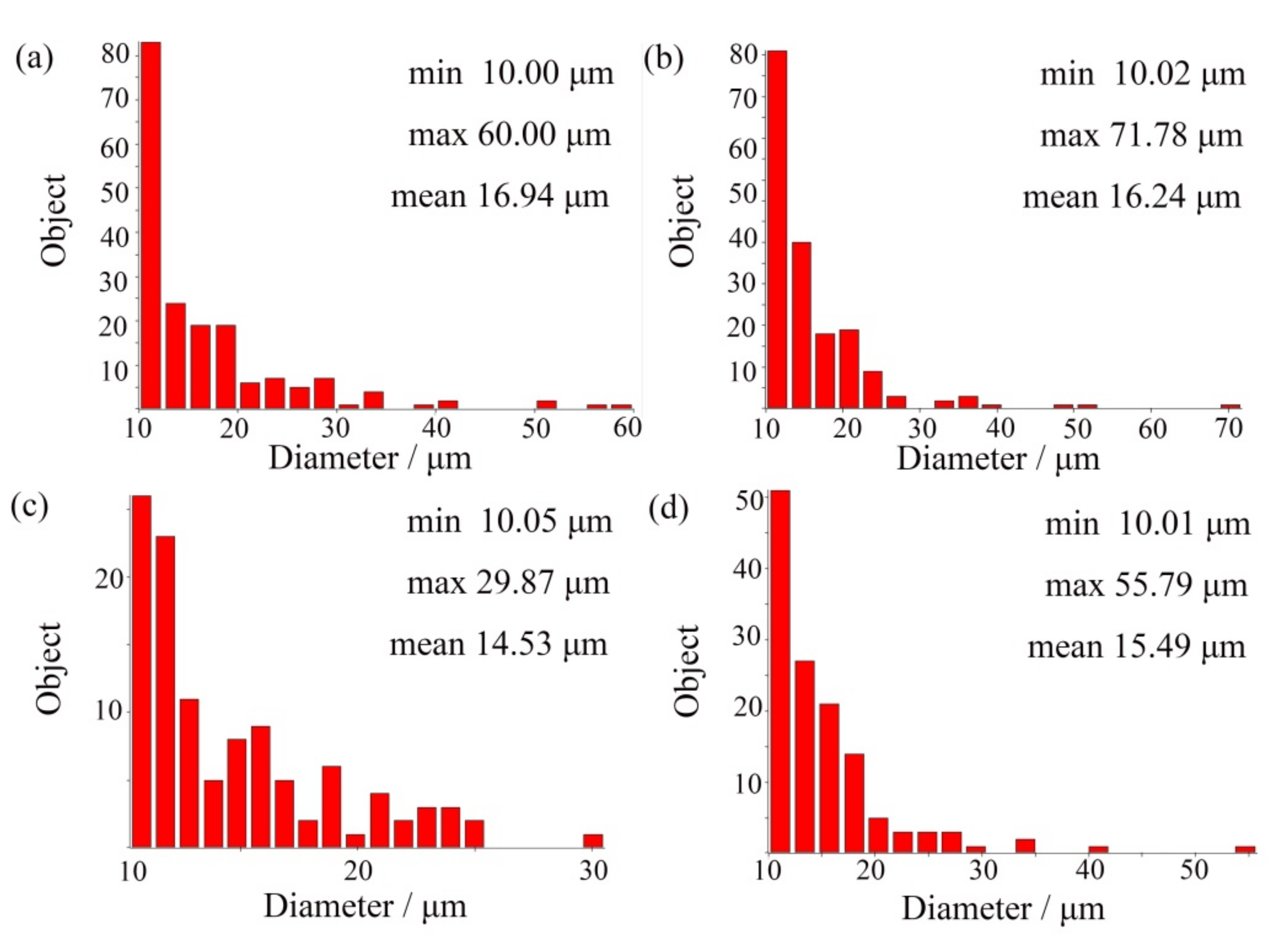
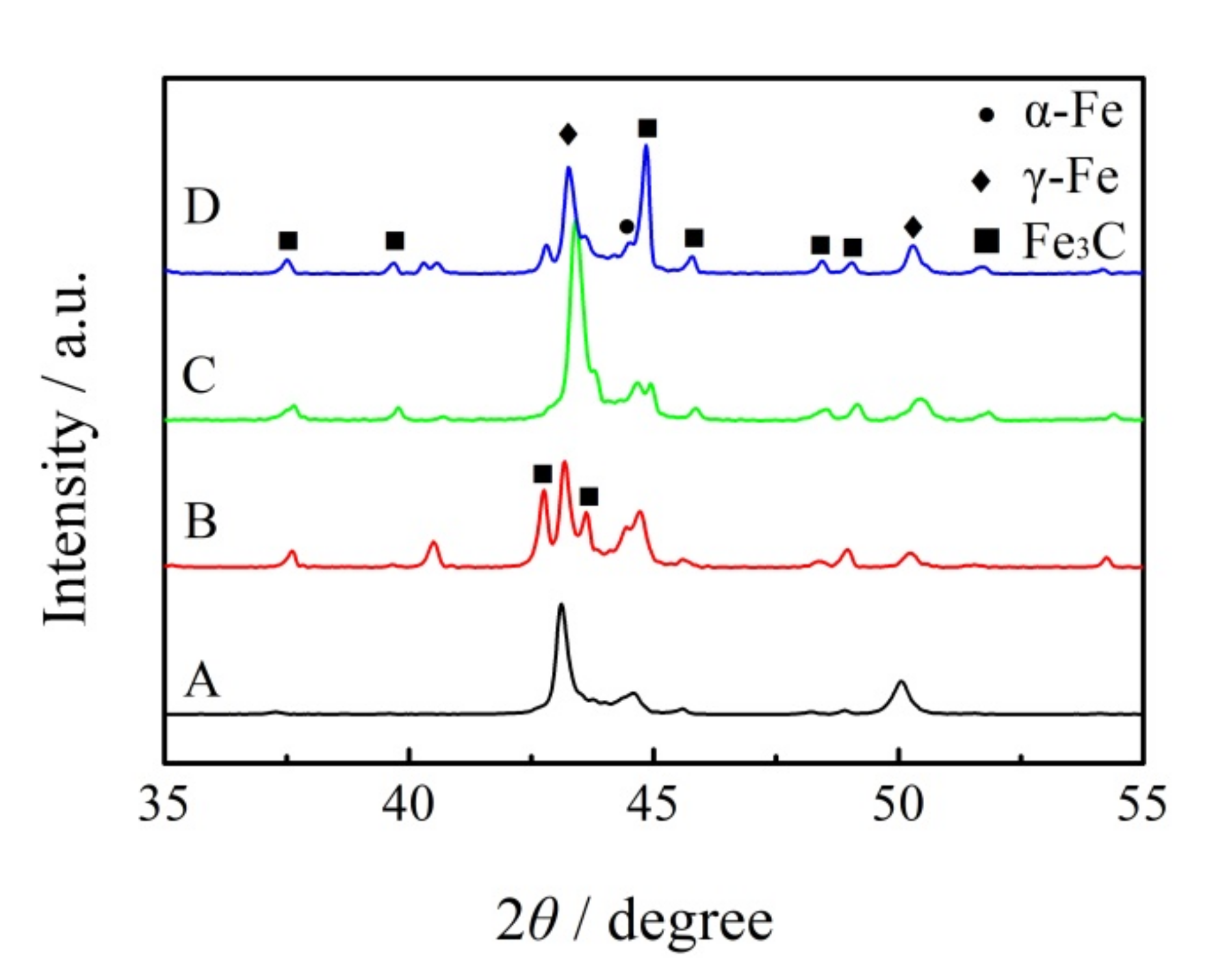
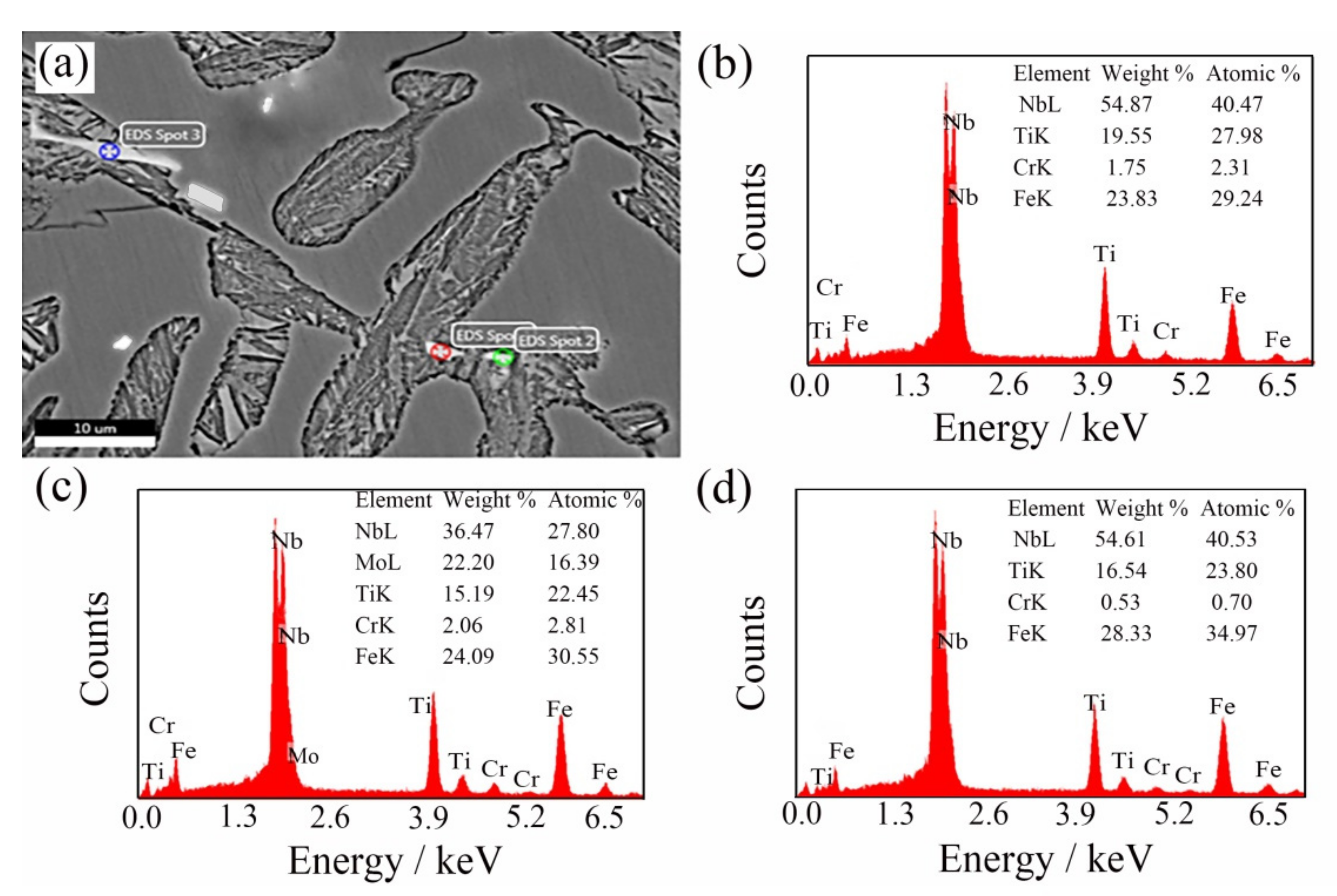
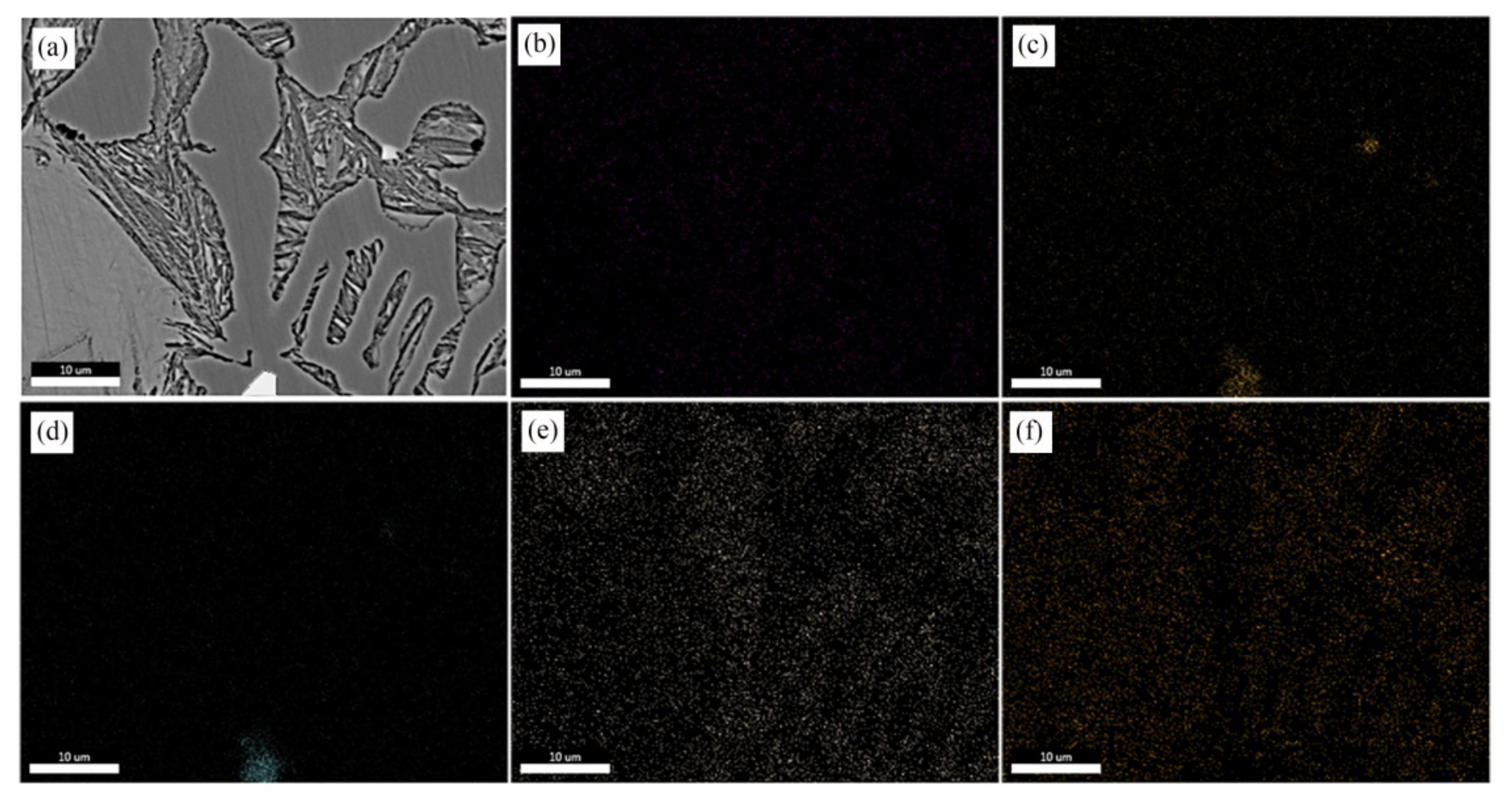
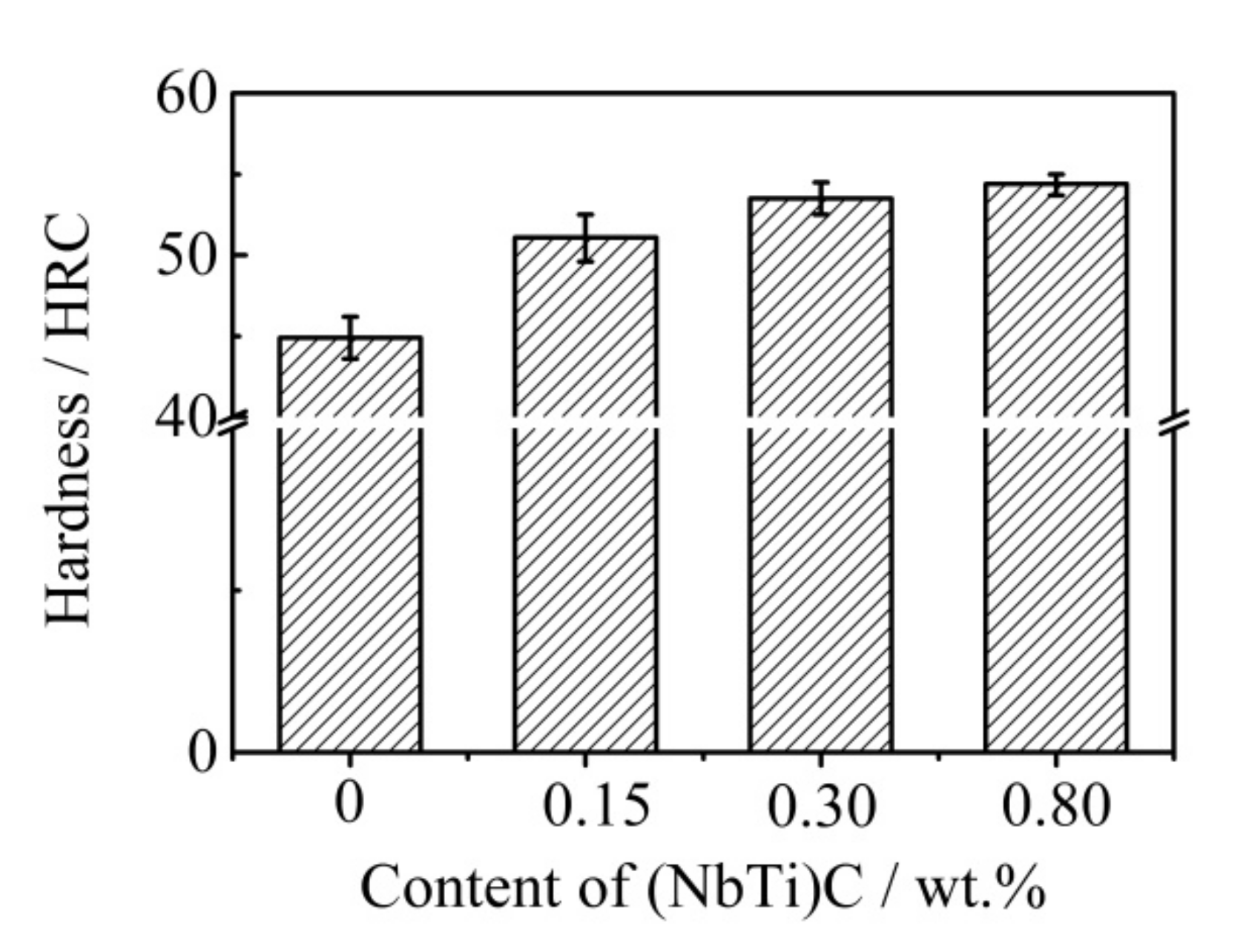
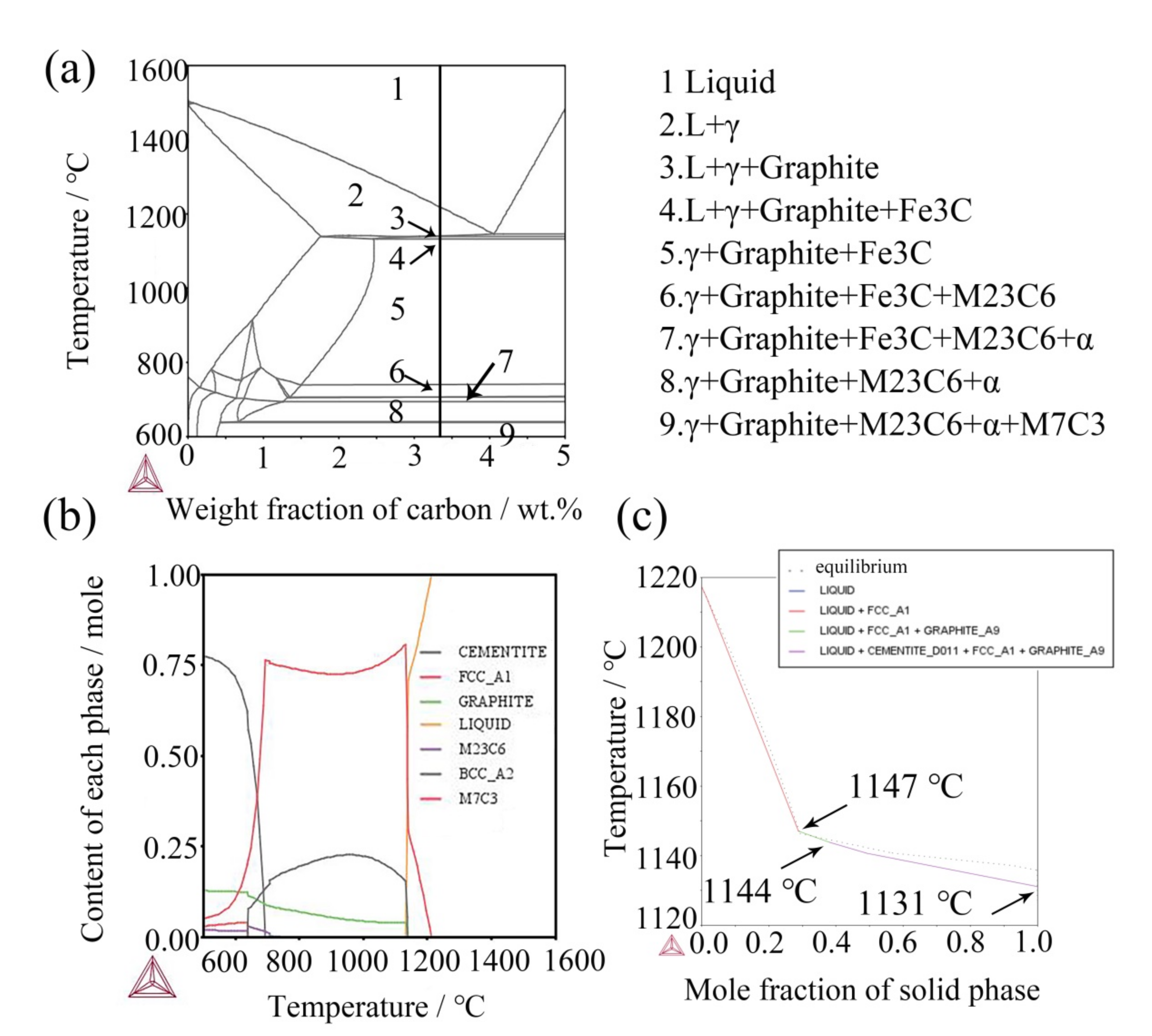
| C | Si | Mn | P | S | Cr | Ni | Mo | V | Fe |
|---|---|---|---|---|---|---|---|---|---|
| 3.40 | 0.70 | 0.92 | 0.041 | 0.026 | 1.76 | 4.50 | 0.40 | 0.023 | Bal. |
Publisher’s Note: MDPI stays neutral with regard to jurisdictional claims in published maps and institutional affiliations. |
© 2022 by the authors. Licensee MDPI, Basel, Switzerland. This article is an open access article distributed under the terms and conditions of the Creative Commons Attribution (CC BY) license (https://creativecommons.org/licenses/by/4.0/).
Share and Cite
Zhu, H.; Xia, S.; Zhai, L.; Dong, J.; Xiao, F. Effect of (NbTi)C Particles on the Microstructure and Hardness of High Chromium and Nickel Indefinite Chilled Cast Iron. Crystals 2022, 12, 978. https://doi.org/10.3390/cryst12070978
Zhu H, Xia S, Zhai L, Dong J, Xiao F. Effect of (NbTi)C Particles on the Microstructure and Hardness of High Chromium and Nickel Indefinite Chilled Cast Iron. Crystals. 2022; 12(7):978. https://doi.org/10.3390/cryst12070978
Chicago/Turabian StyleZhu, Hongwei, Shule Xia, Long Zhai, Jiyu Dong, and Furen Xiao. 2022. "Effect of (NbTi)C Particles on the Microstructure and Hardness of High Chromium and Nickel Indefinite Chilled Cast Iron" Crystals 12, no. 7: 978. https://doi.org/10.3390/cryst12070978






